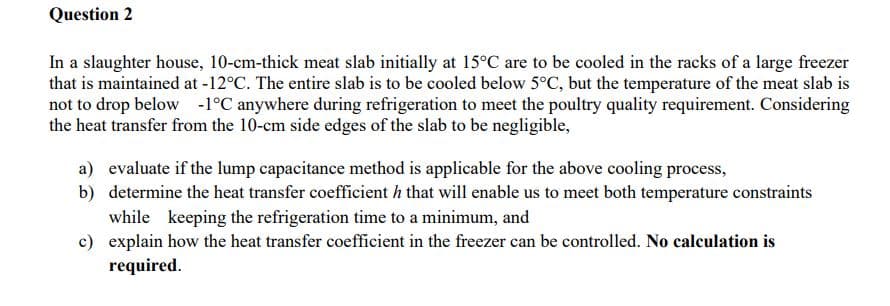In a slaughter house, 10-cm-thick meat slab initially at 15°C are to be cooled in the racks of a large freezer that is maintained at -12°C. The entire slab is to be cooled below 5°C, but the temperature of the meat slab is not to drop below -1°C anywhere during refrigeration to meet the poultry quality requirement. Considering the heat transfer from the 10-cm side edges of the slab to be negligible, a) evaluate if the lump capacitance method is applicable for the above cooling process, b) determine the heat transfer coefficient h that will enable us to meet both temperature constraints while keeping the refrigeration time to a minimum, and c) explain how the heat transfer coefficient in the freezer can be controlled. No calculation is required.
In a slaughter house, 10-cm-thick meat slab initially at 15°C are to be cooled in the racks of a large freezer that is maintained at -12°C. The entire slab is to be cooled below 5°C, but the temperature of the meat slab is not to drop below -1°C anywhere during refrigeration to meet the poultry quality requirement. Considering the heat transfer from the 10-cm side edges of the slab to be negligible, a) evaluate if the lump capacitance method is applicable for the above cooling process, b) determine the heat transfer coefficient h that will enable us to meet both temperature constraints while keeping the refrigeration time to a minimum, and c) explain how the heat transfer coefficient in the freezer can be controlled. No calculation is required.
Principles of Heat Transfer (Activate Learning with these NEW titles from Engineering!)
8th Edition
ISBN:9781305387102
Author:Kreith, Frank; Manglik, Raj M.
Publisher:Kreith, Frank; Manglik, Raj M.
Chapter3: Transient Heat Conduction
Section: Chapter Questions
Problem 3.15P: A thin-wall jacketed tank heated by condensing steam at one atmosphere contains 91 kg of agitated...
Related questions
Question

Transcribed Image Text:Question 2
In a slaughter house, 10-cm-thick meat slab initially at 15°C are to be cooled in the racks of a large freezer
that is maintained at -12°C. The entire slab is to be cooled below 5°C, but the temperature of the meat slab is
not to drop below -1°C anywhere during refrigeration to meet the poultry quality requirement. Considering
the heat transfer from the 10-cm side edges of the slab to be negligible,
a) evaluate if the lump capacitance method is applicable for the above cooling process,
b) determine the heat transfer coefficient h that will enable us to meet both temperature constraints
while keeping the refrigeration time to a minimum, and
c) explain how the heat transfer coefficient in the freezer can be controlled. No calculation is
required.
Expert Solution
This question has been solved!
Explore an expertly crafted, step-by-step solution for a thorough understanding of key concepts.
Step by step
Solved in 3 steps with 3 images

Knowledge Booster
Learn more about
Need a deep-dive on the concept behind this application? Look no further. Learn more about this topic, mechanical-engineering and related others by exploring similar questions and additional content below.Recommended textbooks for you

Principles of Heat Transfer (Activate Learning wi…
Mechanical Engineering
ISBN:
9781305387102
Author:
Kreith, Frank; Manglik, Raj M.
Publisher:
Cengage Learning

Principles of Heat Transfer (Activate Learning wi…
Mechanical Engineering
ISBN:
9781305387102
Author:
Kreith, Frank; Manglik, Raj M.
Publisher:
Cengage Learning